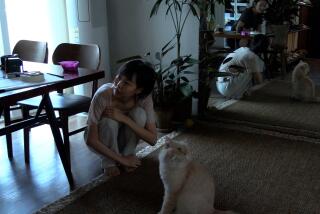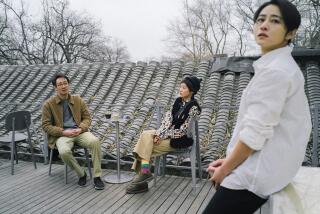Hong Kong film festival changing with the times
Unlike Cannes or Sundance, whose film festivals and their constellation of stars overtake their host cities, nothing overtakes the bristling bustle of Hong Kong, not even the 36th annual Hong Kong International Film Festival, which opens here Wednesday.
At the festival headquarters Tuesday in the Hong Kong Cultural Center in Kowloon, film fans grabbed festival programs and queued up for tickets – even as about 500 school kids shuttled into the complex for an orchestral program.
That’s the reality these days – the festival has to compete for attention in a world, as HKIFF executive director Roger Garcia put it, where “anyone can find a way to see anything anytime.”
The festival is not alone in facing change. It is a time of transition for the Pearl of the Orient, a territory of 7 million that reverted from British to Chinese rule 15 years ago. Hong Kong, perhaps more than any other place outside the mainland, has felt the rise of this new superpower in its art, commerce and politics, and the many of city’s movies in the three-week festival capture that dynamic.
Consider the opening night film, “Love in the Buff,” director Pang Ho-Cheung’s sardonic look at two former lovers who are part of the relatively recent reverse wave of migration -- moving from the ex-colony to Beijing, where job prospects are suddenly brighter. In “Life Without Principle,” Johnnie To crafts an action-satire commenting on wealth-obsessed Hong Kong. And the documentary “Days After n Coming” looks at how an old Hong Kong village was demolished to make way for a high-speed rail link with the mainland.
But the city is hardly alone -- many of the featured movies here (from Japan, South Korea, Taiwan, Indonesia, Thailand and mainland China) reflect the the changing cultural and polticial currents in Asia. The artistic voices are both insistent and insightful.
The festival is still anchored by Hong Kong filmmakers, but increasingly the mix is pan-Asian. “We are not nationalistic,” said Garcia by phone on the eve of the festival. “Our mission has always been to focus on auteurs, and while Hong Kong is a hub of Asian film, we’ve always wanted to bring in filmmakers from other countries to show movies in Hong Kong that people might not otherwise see, or art-house films, that they might not notice.”
The festival’s Edward Yang New Talent award is a result of that sensibility. This year it will go to Indonesian writer/director Edwin, the one-name auteur whose latest film is “Postcards from the Zoo,” a mystical tale of a young girl raised at a Jakarta wildlife park where she was left as a toddler. It comes here after causing a sensation at the Berlin Film Festival. “When we look at young filmmakers, we are looking for that ability to be a game changer,” said Garcia. “And Edwin is that.”
Even the festival’s filmmaker in focus, Peter Chan, is a truly international force. Born in Hong Kong, he grew up in Bangkok, studied film at UCLA and is now one of China’s most prolific, and profitable, filmmakers. He moves across multiple genres, directing and producing in Hollywood (“The Love Letter” with Kate Capshaw) as well as Asia (“The Warlords”). His Applause Pictures, founded with Teddy Chen and Allan Fung, was built on the idea of nurturing ties among Asian filmmakers and has become a cultural and economic model.
While Chan operates from top spheres of influence, most of the filmmakers here are capturing life at street level. Themes of displacement -- whether by economics, age, or natural disasters like the earthquake/tsunami/nuclear meltdown that struck Japan just as last year’s festival was about to begin -- abound.
From Japan, there are two disaster documentaries: “Nuclear Nation” explores the loss of community as entire villages were displaced while in “Fukushima: Memories of a Lost Landscape,” the filmmaker becomes part of a relief crew, he captures images of the dying land. Out of South Korea, there are films about lives on the margins -- the documentary “Moving,” for example, follows the bumpy migration of one Korean couple to New Zealand. The mainland has contributed a narrative look at social issues in “People Mountain People Sea” with drug addiction and expendable humans at its center. From the Phillipines, there is “The Woman in the Septic Tank,” a social satire on the phenomenon of “poverty porn.”
The mix of genres and stories is an eclectic one, with sex, power and action almost as much on filmmakers minds as the drifting economy. The films are not just Asian, but drawn from around the world, with director Angelina Maccarone’s portrait of actress Charlottee Rampling, “The Look,” one of the gala films.
You can feel the influences of the West in subtle, and sometimes not so subtle ways. The Japanese “Go! Boy’s School Drama Club,” plays on the “High School Musical” and “Glee” fascination, which is apparently universal. The 3-D animated “Legend of a Rabbit” is a mainland riff on DreamWorks “Kung Fu Panda.”
The festival is reshaping itself to ensure its relevancy as competing festivals in Pusan and Bangkok are increasingly important in Asia. Business links are expanding ever more radically and rapidly, with U.S. studios forging deals in China nearly every day. Among the most recent is DreamWorks Animation’s plans to build a studio in Shanghai to create original content for China and other international markets, presumably with a focus on Asia.
The speed of change has left the pioneering festival -- the first international fest in Asia at its inception – sprinting to keep pace. Today there are certainly nods to tradition in the line-up of 283 films from 50 countries, but in myriad ways, the festival is casting a wider net.
There are HKIFF-sponsored spin-off festivals in a growing number of Asian cities through the year, and the festival coincides with Filmart, a bazaar with film and TV products for sale. HKIFF has also gotten into the business of making films, not just currating them. This year it funded “Beautiful 2012,” a compilation of shorts from a range of Asian filmmakers. It will premiere at the festival, then be available to Chinese audiences via an arrangement with one of China’s major video-internet sites, Youku (which streamed 450 films last year, many of them from the U.S.).
The festival is also behind a networking effort to link emerging filmmakers with American money. Five are in the final running to pitch their ideas this week as part of the Hong Kong-Asia Film Financing Forum, which has a first look deal with Fox. By the festival’s end, one should have a contract in hand.
Though surviving and thriving has become, as Garcia concedes, far more difficult and challenging for HKIFF, ultimately the mission he said, remains both simple and the same: “Our objective is still to show great movies.”
More to Read
The biggest entertainment stories
Get our big stories about Hollywood, film, television, music, arts, culture and more right in your inbox as soon as they publish.
You may occasionally receive promotional content from the Los Angeles Times.











